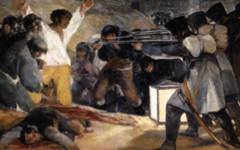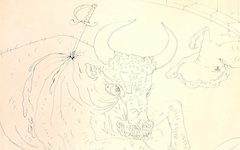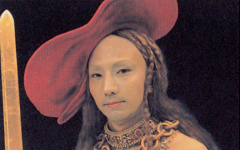Executing Painting
Even today we speak about “executing a painting” or “the artist’s execution of the work” so it should be no surprise that execution is one of the most important allegorical themes in art. Whether the story behind the artist-as-executioner is religious, mythical, fictional or even historical, the underlying subject is always about art with the artist as both executioner and victim. After all, since every painter paints himself (see that Theme), every artist executes himself too. This theme, fusing the artist's imagination of the studio on one level with the painting’s apparent theme on another, takes advantage of the long tradition in which artists have used various weapons, from arrows to rifles, as symbols of their own tools (see Brush and Palette.) It also suggests, since either the executioner or the victim is usually evil, that the artist’s mind (the total image) contains both good and evil (See The Inner Tradition.) In addition, since many such stories tend to contain an executioner of one gender with a victim of the other, the artist can present his/her mind as androgynous, as all truly creative minds always are (See Androgyny) In a further twist, the moment of death has long symbolized the completion of the artist’s creation in any medium. Thus, as the executioner sends the victim to his/her death in the image, the painting-in-process is completed. In “death” it reaches perfection and becomes, somewhat paradoxically, a symbol of the artist’s “immortality”.
Most Recent Articles
All Articles (Alphabetical by Artist, then Title)
Find out, even in the work of a little-known painter, how the executioner is the artist and the victim his painting.

Antonio Campi’s Martyrdom of St. Sebastian
Watch the bloody and cathartic experience of painting a masterpiece
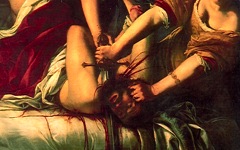
Artemisia Gentileschi’s Judith and Her Maidservant Slaying Holofernes
See Artemisia Gentileschi turned a biblical story into a lesson about art and reality

Artemisia Gentileschi’s Judith and Her Maidservant with the Head of Holofernes
Why would a great poet just depict fruit on a platter with no other content or meaning? The answer: they wouldn't.

Bonnard’s Fruit on a Red Tablecloth (c.1943)
Learn how to note passages between one level of reality and another

Botticelli’s St. Sebastian (c.1473)
See how Caravaggio's iconic painting makes art's basic paradigm crystal clear
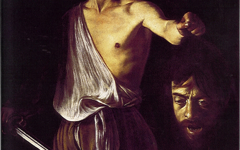
Caravaggio’s David with the Head of Goliath (1610)
Caravaggio executes his painting with a sword just as he executed a man

Caravaggio’s Judith and Holofernes (c.1599)
"Mistakes" in representing reality are cues to the scene's underlying meaning

Caravaggio’s Martyrdom of St. Ursula (1609-10)
One of my first discoveries remains, for me, an object lesson in art. Perhaps for you too.

Carpaccio’s St. George and the Dragon (1502)
See how a divine figure is posed like a sculptor and, as an artist, executes his work

Cellini’s Perseus (1545-54)
Find out how Chagall made obvious what many other artists obscured

Chagall as an Animal (20th century)
Even a minor sketch does not escape a great artist's need to identify
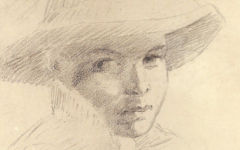
Courbet’s Portrait of a Young Boy
See how Cranach represents himself as an evil man executing "his painting" of spiritual perfection.

Cranach’s Martryrdom of St. Barbara
In Cranach’s 1506 woodcut of Venus and Cupid, Cupid is the artist drawing back the bow to shoot his “victim”.

Cranach’s Venus and Cupid Woodcut
This woodcut by Dürer is known as Cain Killing Abel even though there is no way to know whether the scene is biblical or not. It might just as well be an ordinary scene of murder

Dürer’s Cain Killing Abel
Dürer’s woodcut of The Martyrdom of Saint Sebastian provides further evidence that even religious scenes are self-referential.

Dürer’s Martyrdom of St. Sebastian
Another example of St. Irene "painting" St. Sebastian

Delacroix’s St. Sebastian Helped by the Holy Women (1836)
There has always been a violent streak to artistic creation, often expressed through military metaphor and in scenes of violence or its aftermath.
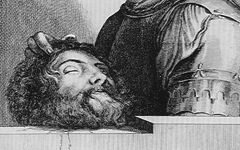
Giorgione’s Self-portrait as David
See how Goya turned a battle in the streets into a battle in his studio.....and his mind

Goya’s 2nd May, 1808 (1814)
The central panel of an altarpiece by Hans Baldung Grien (c. 1480 - 1545) depicts St. Sebastian being shot by two archers while Grien himself stands oddly behind the victim.

Hans Baldung Grien’s St. Sebastian Altarpiece (1507)
The universal features of Frida Kahlo's art are what links her to the canon, not the details of her private life
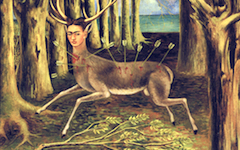
Kahlo’s The Wounded Deer (1946)
This curious painting by Manet makes little sense until the viewer uses the idea that every painter paints himself

Manet’s Boy with a Sword (1861)
Art scholars have sometimes wondered why the execution squad in Manet's Execution of Emperor Maximillian are so unrealistically close to their target. Indeed, on close inspection, their rifles are aimed as though they would miss.
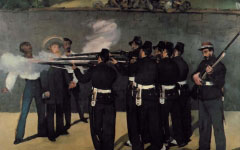
Manet’s Execution of Emperor Maximillian (1867-8)
See how Mantegna like many other masters uses the Execution of St Sebastian to convey the idea that 'every painter paints himself.'

Mantegna’s Saint Sebastian (1480)
David is not difficult to understand as long as you use the correct perspective
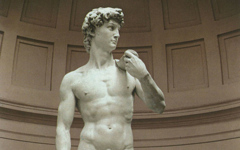
Michelangelo’s David (1501-04)
The theme of an executioner with a decapitated head as a visual metaphor for a painter continues to this day.

Norbert Bisky’s Youths with Decapitated Heads (2006-08)
In this early painting of St. Sebastian by Perugino the artist signed his name as though it was the arrow: "Opus Peruginus Pinxit."

Perugino’s Bust of St. Sebastian (1493)
Learn how Picasso used swords as "paintbrushes", "etching needles" and other tools of the trade

Picasso’s Swords and Knives
See how Rembrandt turned an anatomy lesson into a scene in his studio (in his mind).

Rembrandt’s Anatomy Lesson of Dr. Tulp (1632)
See the sight which changes the meaning of all Rembrandt's art: Rembrandt is Christ
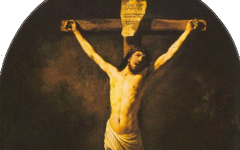
Rembrandt’s Crucifixion (1631)
See how Rembrandt concisely expresses the underlying idea of art in a Roman myth

Rembrandt’s Lucretia (1666)
This painting of a young Rembrandt holding up a dead bird as though he were the hunter has troubled art scholars for years.
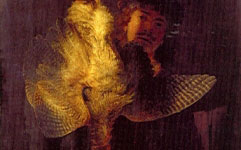
Rembrandt’s Self-portrait with a Dead Bittern (1639)
If you didn't know that EPPH, you would never understand this image….nor would anyone else.

Rembrandt’s The Hog (1643)
How Rembrandt's method, and that of great artists in general, is present in his earliest extant painting
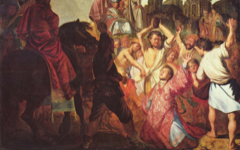
Rembrandt’s The Stoning of St. Stephen (1625)
Discover a common way how artists demonstrate their identity with their protagonist. You can use the method to interpret other paintings by other artists.
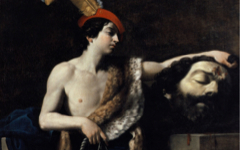
Reni’s David with the Head of Goliath (1605)
In a poster for an exhibition of his paintings (above) Egon Schiele drew on the age-old tradition of presenting St. Sebastian as a symbol for the artist himself suffering the pangs of artistic creation.

Schiele’s Self-portrait as Saint Sebastian (1914-15)
© Simon Abrahams. Articles on this site are the copyright of Simon Abrahams. To use copyrighted material in print or other media for purposes beyond 'fair use', you must obtain permission from the copyright owner. Websites may link to this page without permission (please do) but may not reproduce the material on their own site without crediting Simon Abrahams and EPPH.




